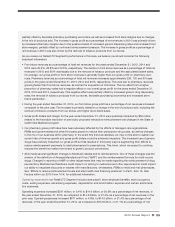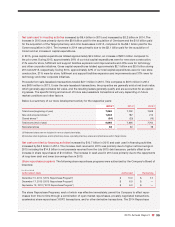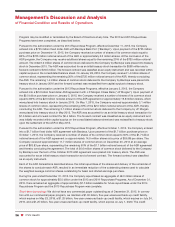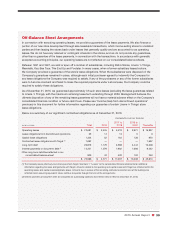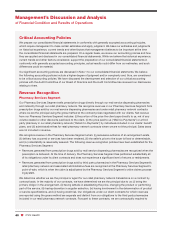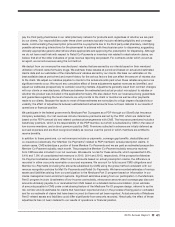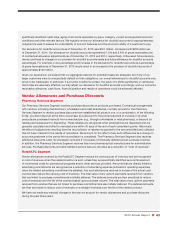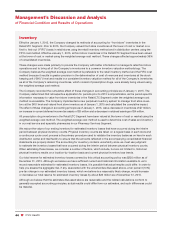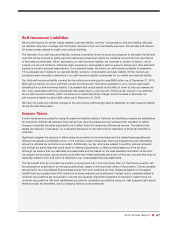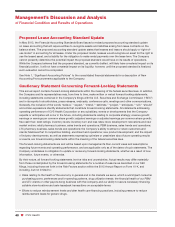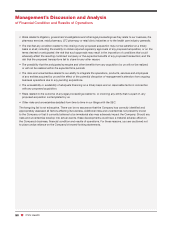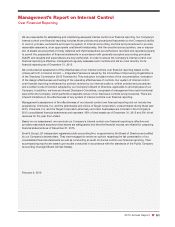CVS 2015 Annual Report Download - page 45
Download and view the complete annual report
Please find page 45 of the 2015 CVS annual report below. You can navigate through the pages in the report by either clicking on the pages listed below, or by using the keyword search tool below to find specific information within the annual report.
43
2015 Annual Report
specifically identified credit risks, aging of accounts receivable by payor category, current and expected economic
conditions and other relevant factors. We regularly review our allowance for doubtful accounts for appropriateness.
Judgment is used to assess the collectability of account balances and the economic ability of a customer to pay.
Our allowance for doubtful accounts as of December 31, 2015 was $161 million, compared with $256 million as
of December 31, 2014. Our allowance for doubtful accounts represented 1.3% and 2.6% of gross receivables (net
of contractual allowance adjustments) as of December 31, 2015 and 2014, respectively. Unforeseen future develop-
ments could lead to changes in our provision for doubtful accounts levels and future allowance for doubtful accounts
percentages. For example, a one percentage point increase in the allowance for doubtful accounts as a percentage
of gross receivables as of December 31, 2015 would result in an increase to the provision of doubtful accounts of
approximately $120 million.
Given our experience, we believe that our aggregate reserves for potential losses are adequate, but if any of our
larger customers were to unexpectedly default on their obligations, our overall allowances for doubtful accounts may
prove to be inadequate. In particular, if economic conditions worsen, the payor mix shifts significantly or reimburse-
ment rates are adversely affected, we may adjust our allowance for doubtful accounts accordingly, and our accounts
receivable collections, cash flows, financial position and results of operations could be adversely affected.
Vendor Allowances and Purchase Discounts
Pharmacy Services Segment
Our Pharmacy Services Segment receives purchase discounts on products purchased. Contractual arrangements
with vendors, including manufacturers, wholesalers and retail pharmacies, normally provide for the Pharmacy
Services Segment to receive purchase discounts from established list prices in one, or a combination, of the following
forms: (i) a direct discount at the time of purchase, (ii) a discount for the prompt payment of invoices or (iii) when
products are purchased indirectly from a manufacturer (e.g., through a wholesaler or retail pharmacy), a discount (or
rebate) paid subsequent to dispensing. These rebates are recognized when prescriptions are dispensed and are
generally calculated and billed to manufacturers within 30 days of the end of each completed quarter. Historically,
the effect of adjustments resulting from the reconciliation of rebates recognized to the amounts billed and collected
has not been material to the results of operations. We account for the effect of any such differences as a change in
accounting estimate in the period the reconciliation is completed. The Pharmacy Services Segment also receives
additional discounts under its wholesaler contracts if it exceeds contractually defined annual purchase volumes.
In addition, the Pharmacy Services Segment receives fees from pharmaceutical manufacturers for administrative
services. Purchase discounts and administrative service fees are recorded as a reduction of “Cost of revenues”.
Retail/LTC Segment
Vendor allowances received by the Retail/LTC Segment reduce the carrying cost of inventory and are recognized
in cost of revenues when the related inventory is sold, unless they are specifically identified as a reimbursement
of incremental costs for promotional programs and/or other services provided. Amounts that are directly linked to
advertising commitments are recognized as a reduction of advertising expense (included in operating expenses)
when the related advertising commitment is satisfied. Any such allowances received in excess of the actual cost
incurred also reduce the carrying cost of inventory. The total value of any upfront payments received from vendors
that are linked to purchase commitments is initially deferred. The deferred amounts are then amortized to reduce
cost of revenues over the life of the contract based upon purchase volume. The total value of any upfront payments
received from vendors that are not linked to purchase commitments is also initially deferred. The deferred amounts
are then amortized to reduce cost of revenues on a straight-line basis over the life of the related contract.
We have not made any material changes in the way we account for vendor allowances and purchase discounts
during the past three years.


